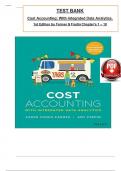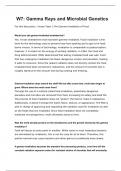, Test Bank for Cost Accounting: With Integrated Data
w w w w w w w
Analytics, 1st Edition by Karen Congo Farmer
w w w w w w w
CHAPTER 1 w
COST ACCOUNTING HAS PURPOSE w w w
CHAPTER LEARNING OBJECTIVES w w
1. Explore the elements that support a company’s purpose, as well as your own.
w w w w w w w w w w w w
2. Connect the purpose of cost accounting with the role of accountants in organizations.
w w w w w w w w w w w w
3. Outline the frameworks, including ethics, that guide the profession.
w w w w w w w w
*4. Increase your chances of success by becoming a lifelong learner.
w w w w w w w w w
Current count is:
w w
Knowledge: 106 w
Comprehension: 5 w
Application: 0 w
Analysis: 0 w
Evaluation: 0 w
Synthesis: 0 w
Total: 111
w
Number and percentage of questions:
w w w w
Easy: 27 questions, 24 percent (target of 25%)
w w w w w w w
Medium: 74 questions, 66 percent (target of 65%)
w w w w w w w
Hard: 10 questions, 9 percent (target of 10%)
w w w w w w w
Question types:w
Multiple Choice: 93
w w
Exercises: 18 w
, 1-2 Test Bank for Cost Accounting, First Edition
MULTIPLE CHOICE QUESTIONS w w
1. A w helps an organization, whether for profit or nonprofit, turn its purpose
w w w w w w w w w w w
into action by establishing the direction of the entity.
w w w w w w w w w
a. mission statement w
b. strategic plan w
c. SWOT analysis w
d. vision
Ans: wB, wLO w1, wBloom: wK, wDifficulty: wMedium, wAACSB: wAnalytic, wAICPA: wFC: wMeasurement, wAnalysis, wand wInterpretation, wIMA: wBusiness wAcumen
w& w Operations: wOperational wKnowledge.
Solution: wA wstrategic wplan whelps wan worganization, wwhether wfor wprofit wor wnonprofit, wturn wits wpurpose winto waction wby westablishing wthe wdirection wof wthe wentity.
2. An organization’s strategic plan includes its why, where and how for its purpose
w w w w w w w w w w w w
represented by
w w
a. opportunities, strengths and weaknesses. w w w
b. opportunities, strengths, and mission. w w w
c. mission, vision, and strategy.
w w w
d. mission, strengths, and strategy.
w w w
Ans: wC, wLO w1, wBloom: wK, wDifficulty: wMedium, wAACSB: wAnalytic, wAICPA: wFC: wMeasurement, wAnalysis, wand wInterpretation, wIMA: wBusiness wAcumen
w& w Operations: wOperational wKnowledge.
Solution: wAn worganization’s wstrategic wplan wincludes wits wwhy, wwhere, wand whow wfor wits wpurpose wrepresented wby wmission, wvision, wand wstrategy.
3. In choosing a strategy, a business begins by undertaking a thorough examination of itself
w w w w w w w w w w w w w
and the industry within which it operates by performing a
w w w w analysis. w w w w w w w w
a. mission and vision statement
w w w
b. strategic initiative w
c. target objectivew
d. SWOT
Ans: wD, wLO w1, wBloom: wK, wDifficulty: wMedium, wAACSB: wAnalytic, wAICPA: wFC: wMeasurement wAnalysis wand wInterpretation, wIMA: wBusiness wAcumen w&
wOperations: w Operational wKnowledge.
Solution: wIn wchoosing wa wstrategy, wa wbusiness wbegins wby wundertaking wa wthorough wexamination wof witself wand wthe windustry wwithin wwhich wit woperates wby
wperforming wa w SWOT wanalysis.
4. An organization’s
w w w is its purpose; its reason for existing.
w w w w w w
a. mission
b. strategy
c. initiative
d. strategic plan w
Ans: wA, wLO w1, wBloom: wK, wDifficulty: wMedium, wAACSB: wAnalytic, wAICPA: wFC: wMeasurement, wAnalysis, wand wInterpretation, wIMA: wIMA: wBusiness
wAcumen w& w Operations: wOperational wKnowledge.
Solution: wAn worganization’s wmission wis wits wpurpose, wits wreason wfor wexisting.
5. A SWOT analysis allows an organization to assess its
w w w w w w w w
a. strategies, wealth, outlets, and targets.
w w w w
b. strengths, warnings, outlets, and threats.
w w w w
c. strengths, weaknesses, opportunities, and threats.
w w w w
d. strategies, wealth, opportunities, and threats.
w w w w
Ans: wC, wLO w1, wBloom: wC, wDifficulty: wEasy, wAACSB: wAnalytic, wAICPA: wFC: wMeasurement, wAnalysis, wand wInterpretation, wIMA: wBusiness wAcumen w&
wOperations: w Operational wKnowledge.
Solution: wA wSWOT wanalysis wallows wan worganization wto wassess wits wstrengths, wweaknesses, wopportunities, wand wthreats.
, 1-3 Test Bank for Cost Accounting, First Edition
6. What is a narrative that describes what the organization will look like, or a destination
w w w w w w w w w w w w w w
to achieve, by some future date called?
w w w w w w w
a. SWOT analysis w
b. Strategic plan w
c. Vision
d. Mission
Ans: wC, wLO w1, wBloom: wK, wDifficulty: wMedium, wAACSB: wAnalytic, wAICPA: wFC: wMeasurement, wAnalysis, wand wInterpretation, wIMA: wBusiness wAcumen
w& w Operations: wOperational wKnowledge.
Solution: wA wnarrative wthe wdescribes wwhat wthe worganization wwill wlook wlike, wor wa wdestination wto wachieve, wby wsome wfuture wdate wis wcalled wa wvision.
7. Which of the following statements is correct regarding a SWOT analysis?
w w w w w w w w w w
a. The basis for evaluation using the SWOT analysis focuses on external factors only.
w w w w w w w w w w w w
b. Factors to assess in a SWOT analysis included elements described in Porter’s Five Forces.
w w w w w w w w w w w w w
c. Insignificant in setting a company’s strategy is determining the organization’s
w w w w w w w w w
critical success factors.
w w w
d. A SWOT analysis is typically used in the Mission and Vision stage in creating the
w w w w w w w w w w w w w w
strategic plan for an organization.
w w w w w
Ans: wB, wLO w1, wBloom: wC, wDifficulty: wMedium, wAACSB: wAnalytic, wAICPA: wFC: wMeasurement, wAnalysis, wand wInterpretation, wIMA: wBusiness wAcumen
w& w Operations: wOperational wKnowledge.
Solution: wThe wcorrect wstatement wregarding wSWOT wanalysis wis,‖ w Factors wto wassess win wa wSWOT wanalysis wincluded welements wdescribed win wPorter’s wFive wForces.‖
8. Which balanced scorecard perspective considers how an organization supports its people
w w w w w w w w w w
and infrastructure to drive and maintain new products and service development and
w w w w w w w w w w w w
growth?
w
a. Financial perspective w
b. Customer perspective w
c. Internal business process perspective
w w w
d. Learning and growth perspective w w w
Ans: wD, wLO w1, wBloom: wK, wDifficulty: wMedium, wAACSB: wAnalytic, wAICPA: wFC: wMeasurement, wAnalysis, wand wInterpretation, wIMA: wBusiness wAcumen
w& w Operations: wOperational wKnowledge.
Solution: wThe wlearning wand wgrowth wperspective wconsiders whow wan worganization wsupports wits wpeople wand winfrastructure wto wdrive wand wmaintain wnew
wproducts wand w service wdevelopment wand wgrowth.
9. Which of the following represent internal factors in the SWOT analysis?
w w w w w w w w w w
a. Opportunities and threats w w
b. Strengths and weaknesses w w
c. Strengths and opportunities w w
d. Weaknesses and threats w w
Ans: wB, wLO w1, wBloom: wK, wDifficulty: wEasy, wAACSB: wAnalytic, wAICPA: wFC: wMeasurement wAnalysis wand wInterpretation, wIMA: wBusiness wAcumen w&
wOperations: w Operational wKnowledge.
Solution: wInternal wfactors win wthe wSWOT winclude wstrengths wand wweaknesses.
10. The correct flow of the steps in the creation of an organization’s strategic plan is
w w w w w w w w w w w w w w
a. Mission and Vision→Strategies and Initatives→Goals and Objectives→Measures
w w w w w w
and Targets→Results
w w
b. Mission and Vision→Goals and Objectives→Strategies and Initiatives→Measures
w w w w w w
and Targets→Results
w w
c. Strategies and Initatives→Goals and Objectives→Mission and Vision→Measures
w w w w w w
and Targets→Results
w w
d. Mission and Vision→Measures and Targets→Strategies and Initatives→Goals
w w w w w w
and Objectives→Results
w w
Ans: wB wLO w1, wBloom: wK, wDifficulty: wMedium, wAACSB: wAnalytic, wAICPA: wFC: wMeasurement, wAnalysis, wand wInterpretation, wIMA: wBusiness wAcumen w&
wOperations: w Operational wKnowledge.
Solution: wThe wcorrect wflow wof wthe wsteps win wthe wcreation wof wan worganization’s wstrategic wplan wis wMission wand wVision→Goals wand
wObjectives→Strategies wand w Initiatives→Measures wand wTargets→Results





